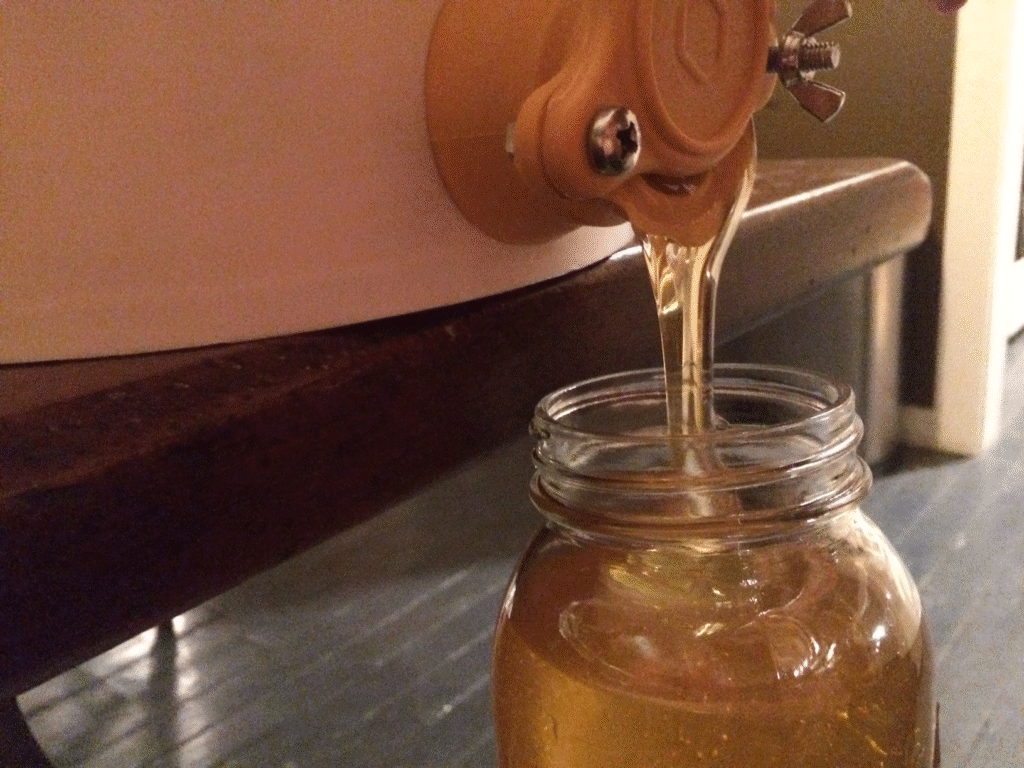Discover the complete guide to honey bottling for beekeepers and businesses. Learn preparation, bottling methods, container options, labeling, storage, and solutions to common challenges to produce safe, market-ready honey.
Honey bottling is the final and crucial step in honey processing before it reaches consumers. Proper bottling preserves the honey’s quality, extends shelf life, and ensures it’s safe and attractive for sale. Below is a detailed breakdown of the honey bottling process:

1. Preparation Before Bottling
🔹 Filtering
- Purpose: Removes wax particles, bee parts, and debris.
- Methods: Use of a fine mesh strainer, cheesecloth, or commercial filters (around 200–400 microns).
- Note: Over-filtering can strip beneficial pollen.
🔹 Settling
- Honey is allowed to settle for 24–48 hours in a tank or container.
- During this time, air bubbles and fine particles rise to the surface and are skimmed off.
- This helps in getting a clearer product with fewer impurities.
2. Heating (Optional)
- Light warming may be used to reduce viscosity for easier bottling.
- Optimal temp: Around 35–40°C (95–104°F).
- Avoid temperatures above 50°C (122°F) to preserve enzymes and nutrients.
- Heating is optional and avoided in raw honey bottling.
3. Bottling Equipment
Manual Methods
- Honey gate valve at the base of the container.
- Pour into bottles/jars manually — good for small operations.
Semi-Automatic Bottlers
- Foot-pedal or button-activated pumps.
- Faster and more consistent than manual bottling.
Automatic Bottling Lines
- Conveyor-belt systems for large-scale production.
- Includes filling, capping, and labeling.
4. Choosing Bottles or Jars
- Materials: Food-grade plastic (PET), glass jars, or squeeze bottles.
- Cap types: Flip-top, screw-on, or tamper-proof seals.
- Sizes: Common sizes include 250g, 500g, 1kg.
Labeling
- Include:
- Product name (“Pure Honey” / “Raw Honey”)
- Net weight
- Harvest date or batch number
- Origin (e.g., “Product of Kenya”)
- Producer’s name and contact
- Optional: Nutritional info, usage tips, certification logos (e.g., organic)
5. Quality Control
- Moisture Content Check: Ideal range is 17–18.5%.
- Use a refractometer to measure.
- Clarity and color: Consistency matters — cloudy honey may need explanation (e.g., raw or crystallized).
- Crystallization: Natural and not a defect; can be controlled with fine filtering or by creaming.
6. Storage and Distribution
- Store in cool, dry places (ideally below 25°C).
- Protect from direct sunlight to prevent degradation.
- Use airtight containers to avoid moisture absorption (honey is hygroscopic).
Final Thoughts
Honey bottling is more than just filling jars—it is about preserving the natural goodness of honey while ensuring safety, quality, and consumer satisfaction. With the right methods, equipment, and branding, beekeepers can add significant value to their honey and build loyal markets.
Frequently Asked Questions on Honey Bottling
- What is the best way to prepare honey for bottling?
By filtering, settling, controlling moisture, and gently warming if needed. - What water content should honey have before bottling?
Ideally below 20 percent to avoid fermentation. - Can I bottle honey without filtering?
Yes, but it may contain wax, pollen, or debris, which reduces clarity. - Why does honey crystallize in bottles?
It is a natural process caused by glucose separating from water. - How do you prevent honey from fermenting?
Maintain low moisture content and use airtight containers. - What type of jars are best for honey?
Glass jars are preferred for premium quality, while plastic bottles are practical for everyday use. - Can honey go bad after bottling?
Properly bottled honey does not spoil, but it may ferment if moisture is too high. - Should honey be heated before bottling?
Only gently and below 40°C to avoid damaging enzymes and nutrients. - How do I remove air bubbles from honey?
Allow the honey to rest in tanks before bottling to release trapped air. - What is the shelf life of bottled honey?
Indefinite if properly sealed and stored, though flavor and aroma may change over time. - Is creamed honey bottled differently?
Yes, it is whipped or seeded before bottling to control crystallization. - Do I need special licenses for honey bottling?
In many countries, food safety certification and labeling regulations apply. - What information must be on a honey label?
Product name, net weight, producer information, and sometimes nutritional details. - Can honey be stored in metal containers?
Not recommended, as honey’s acidity can react with metal. - How do commercial producers bottle honey efficiently?
They use semi-automatic or fully automatic bottling machines. - What causes foam on bottled honey?
Air bubbles from extraction or settling, which can be reduced by resting before bottling. - Is raw honey bottled differently from processed honey?
Raw honey is minimally filtered and bottled directly without pasteurization. - Can I reuse honey jars?
Yes, if they are properly sterilized to avoid contamination. - How do I bottle honey for retail sales?
Use food-grade containers, apply attractive labels, and meet regulatory standards. - How do I add value to bottled honey?
Through premium packaging, organic certification, unique flavors, and eco-friendly branding.